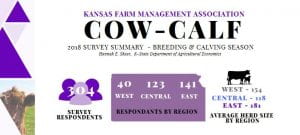By Kevin Herbel, Executive Director – KFMA Program
The Kansas Farm Management Association (KFMA) has worked together with cow-calf producers keeping records of the cow-calf enterprise for many years. This has allowed for analysis and assessment of the cow-calf enterprise on individual operations. The data available through this process has provided the opportunity for benchmarking to be completed against the averages and against the data based on profitability levels. Reports have included looking at differences between high-, medium-, and low-profit producers, with the most recent report covering cow-calf enterprises in the KFMA database from 2014-2018 (http://agmanager.info/livestock-meat/production-economics/differences-between-high-medium-and-low-profit-cow-calf-1). When prior year results were shared at the Risk and Profit Conference held in Manhattan, Kansas in August 2018, feedback received suggested that more detailed information, particularly related to production practices, could provide crucial information to help analyze which management decisions may be impacting profitability.
Following this, a group of KFMA economists worked together to create a system to collect some of this additional data. Included were pre-conditioning practices (i.e. feed bunk experience, vaccination, castration, weaning, etc.), animal identification, breeding selection, breeding and calving season management, hay feeding, and marketing. From the KFMA membership, over 300 cow-calf producers participated in this data collection process. This response supports the expressed desire and need for providing more complete economic analysis for cow-calf producers, and their interest in being involved in the process.
These responses were matched up with the KFMA enterprise database. There were 174 cow-calf producers with an enterprise analysis in the 2018 Cow-Calf Enterprise Summaries (2018 Enterprise Reports). Comparing this database with the additional data collected allowed for 89 matched sets of data. These data sets were used to complete the report, A Snapshot of Kansas Cow-Calf Producers: An Analysis of 2018 Kansas Farm Management Association Cow-Calf Enterprises. This report includes general summary data, as well as, some economic analysis of the data. The report first provides a summary of the 2018 cow-calf KFMA data including a cost break down, based on profit thirds. A summary of the additional data is provided and includes the data on a regional basis (east, central, west) to provide an understanding of how management decisions may differ across the state. The final portion of the report combines the additional data with the KFMA database to analyze how specific management decisions impacted a producer’s profitability including the relationship between days on feed with acres per cow, days fed hay with non-pasture feed costs, pregnancy checking and breeding soundness on calving percentage, and more.
Three summary Fact Sheets have also been released regarding this cow-calf data. These reports include:
Breeding and Calving Season – An evaluation of breeding and calving season management on Kansas cow-calf operations; Feed and Pasture Management – An evaluation of the length of the hay feeding season on cow-calf operations and some of the economic impacts; and, Pre-conditioning Practices – An evaluation of various pre-conditioning practices including weaning, dehorning, castration, vaccines and parasite control and feed bunk familiarity.
It is important to note that this report is only a snapshot of KFMA cow-calf producers for 2018. Differences in profitability in a given year are due to more than any specific management decision, therefore this “snap-shot” should be considered from the understanding that this is just a one-year summary. This fall (2019) we have worked to revise and improve the process and plan to continue this additional data collection in future years. From this process we will look to garner better data from cow-calf producers so that we can provide useful analysis on management practices that are impacting profitability, as well as, provide useful and timely benchmarking information for individual producers and the industry.